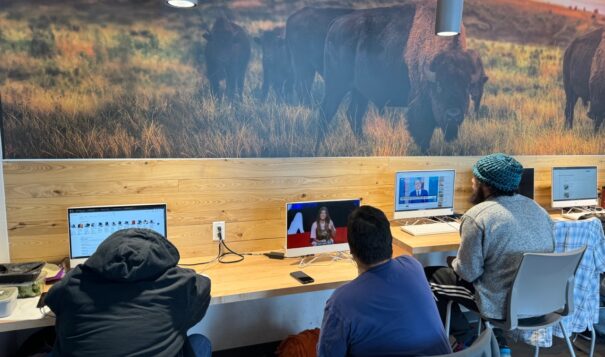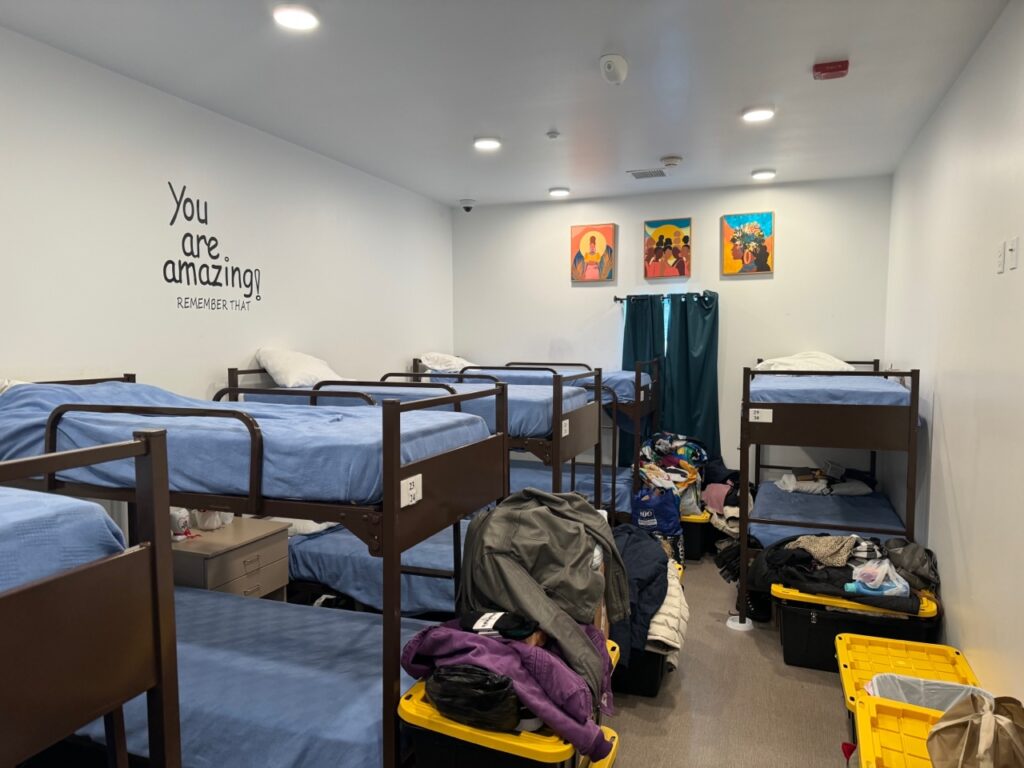News Based on facts, either observed and verified directly by the reporter, or reported and verified from knowledgeable sources.
Extreme cold exposes gaps facing homeless population
 Members of the homeless community sheltering from the cold in Bismarck use computers at Missouri Slope Areawide United Way’s Center for Opportunity. (Photo credit, Michael Standaert.)
Members of the homeless community sheltering from the cold in Bismarck use computers at Missouri Slope Areawide United Way’s Center for Opportunity. (Photo credit, Michael Standaert.)
Better coordination, more funding needed, providers say
Missing a bus would be an inconvenience for most people. For Raymond Mallard, a 53-year-old homeless man, it was fatal. He appears to have missed a bus back to Bismarck from Mandan and died from exposure on the coldest night of the year.
Sometime on the evening of Jan. 13 on into the morning, as temperatures dropped to -21 with a windchill in the -60s, Mallard succumbed outside Wildwood Mobile Home Park.
“He was visiting one of his friends and he was coming back that night. He was walking here,” said his relative Lisa Ireland during an interview at the homeless shelter Ministry on the Margins in Bismarck. “He just missed the bus.”
Ireland herself has been homeless for nearly a year. She and others at the shelter are among some 2,500 homeless people in the state, according to the most recent data from the North Dakota Homeless Management Information system.
Discussions with homeless people and those who provide food, shelter and care for them, paint a picture of haphazard municipal management, a lack of overall funding, and little direction from the state.
Those gaps literally leave many out in extreme conditions like those that hit the state in early and mid-January.

There is no low-barrier shelter in Bismarck during daytime hours, leaving homeless who suffer from active addiction no choice but to get out of the cold at a public library or business places. There aren’t any shelters across the river in Mandan for those in Mallard’s condition, either.
“This winter is probably one of the hardest winters I’ve been through,” said Robin Martin, who stays at Ministry on the Margins in the evening. Originally from North Dakota, he previously wintered in Rapid City, S.D., after becoming homeless. “It’s cold out there.”
Martin said there’s a need in Bismarck for at least an emergency warming shelter in the daytime during cold weather, if not another shelter. The public library, hospitals or other businesses aren’t a good solution, because the homeless are usually forced out, he said.
“If you find a place to warm up at, they kick you out right away,” Martin said.
After discussions among the Missouri Valley Coalition for Homeless People, the Ministry on the Margins (MoM) decided to open earlier during the latest extreme cold period and unlocked its doors at 5 p.m. instead of the usual 10 p.m.
The high-barrier shelter run by Missouri Slope Areawide United Way provided space for anyone homeless during the daytime in the extreme cold period. High-barrier facilities have daily breathalyzer and drug testing to ensure clients are clean while low-barrier centers do not.
Those not staying the night had to trek the mile-and-a-half to Ministry on the Margins twice per day during extreme cold, or shelter where they could. Back in mid-December in Bismarck, a homeless woman also died of exposure, while another, known to be struggling with addiction, was killed by a train strike later that month.
Sr. Kathleen Atkinson, who runs MoM, said that while there’s emergency response during floods and other events, there is a lack of government coordination about cold weather. During the extreme cold, the shelter housed 45 to 55 people per night, she said.
“These would be those who are in active addiction, or have a mental health issue,” Atkinson said. “They would be among the three people that died, so far.”
Atkinson said there is state and municipal money to fund shelters like hers, but she sees a bigger issue at play.
“There’s not a united vision or a moral, strategic, collaborative leadership,” she said.
Over at the United Way shelter, the homeless crowded in where they could during the day. It was an “unplanned plan,” according to executive director Jena Gullo, and a repeat of last winter.
“We’re taking people from Ministry on the Margins during the daytime because we don’t want them to die, outside,” Gullo said. “And they will certainly die outside. The unfortunate thing is that it was cold weeks ago, and just because it wasn’t sub-zero, it was too cold for people to be outside.”
Gullo said the coalition has been providing for “unmet needs,” but ultimately United Way doesn’t have the funding to sustain long-term assistance for those who fall through those gaps.
“If we would have said no, what would have happened?” said Gullo, referencing the decision to open the doors to all homeless during the daytime in recent weeks.
Brighter spots
Elsewhere, communities and community leaders have stepped up to fill local gaps during emergency situations.
In Fargo, a winter warming center at the Downtown Engagement Center is available to protect some among the state’s largest homeless population of 1,000 people, a number that includes the southeast region.
“Knowing that the rates of homelessness were trending upward, we wanted to make sure that there was an additional place that people were able to access to get out of the elements,” said Chandler Esslinger, who works with the harm reduction program at Fargo Cass Public Health.
“It’s not a traditional shelter setting, but it is a place intended to provide respite and get people out of the elements to ensure that there’s no adverse health effects, injury due to cold weather or cold weather-related deaths,” she said.
Esslinger said the city certainly learned a lot that it is willing to share as a possible template for other municipalities across the state.
“We’ve identified a population that needs to be served in this way, folks that don’t fit with other area shelters that specialize in families, single adult men, or veterans,” she said. “We’re really working to ensure that those folks who maybe fall through the cracks of that system still have a place to be and I do think that’s a conversation that can be had across the state.”
Sherry Adams, Southwestern District Health Unit administrator in Dickinson, said local police recognized an emergency due to the severe cold and called her on Jan. 10 to spearhead a response.
That response included reopening a facility that had previously been used for the Covid emergency. Initially, 10 cots were set up for men, then later space for women was added, and another section for anyone who came in sick. Two homeless came the first day and seven more trickled in on the following days, she said. Services included three meals a day and shuttling to a local truck stop for showers.
Even after the extreme cold subsided, Adams said she didn’t want to just force people out, so she worked with area partners on getting case managers to find housing for at least another month. Several of those who came in have been placed in jobs, she said.
“I feel like it’s a success story in the fact that at least we know we saved a few lives in the storm but we’re also making a different impact in following up with them,” Adams said.
In other, more rural areas, gaps are wide. Providers in the Williston and Watford City area and northwest region are mostly churches, according to a provider who mainly focuses on homeless victims of abuse and who estimated homeless at over 150 in that area.
In Devils Lake, the area shelter has space for 12 people, and staff there said they weren’t overwhelmed during the recent cold but said the population is likely around 175 homeless, with many of those staying with family, friend’s couches or sleeping in hallways above apartment buildings in the downtown area.
Neither provider wanted to be quoted on the record for fear of losing funding.
Back at Ministry on the Margins, homeless people there said they felt there was a general lack of compassion among the wider community and that any small measure would help.
Wayne Fast Horse, a good friend of Mallard, said providing bus or other transportation passes could help, and that a warming house is needed.
Brenda Bruning, who was at MoM accompanying a relative with an elementary school age daughter on the verge of homelessness, said another shelter is needed in the area.
“I think they could easily even use another shelter in Bismarck, because United Way, man, it’s packed,” Bruning said.

Lara Riley
Thank you all for what you do, I was homeless and I had to freeze until 10 pm in Bismarck then we got in. It was only for one day but thank God it was there. I give back by cooking n dropping off food water n soda when I can and let my brothers n sisters know I’m still here with you. If I can do more I will. I pray every day. For them. Thank you